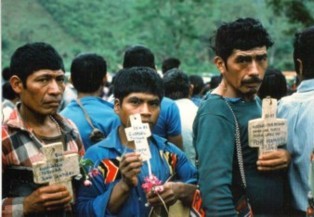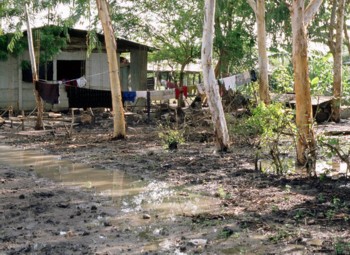|
About the Maya of the CPR-Sierra
The CPR-Sierra (Communities of Population in Resistance of the Sierra) are primarily Ixil and Quiché Maya subsistence farmers from the Ixil area of northern Quiché, Guatemala, one of the areas hardest hit during Guatemala's long and violent internal conflict. At the height of the conflict, the Guatemalan military, by its own count, destroyed 440 Mayan villages. Over 250,000 civilians were killed or "disappeared," scorched-earth campaigns ravaged rural communities, and families became refugees in their own country. |
|
In the Ixil area many internally displaced families fled beyond roads and into the remotest mountains, where they began to organize as the CPR-Sierra. They were subjected to years of bombing, artillery attacks, army incursions, and crop destruction. They estimate half their number died of hunger, bombardments, massacres, treatable diseases, and exposure. Although the mountains were culturally "home," few CPR families had clear title to the lands to which they fled. Under terms of the Guatemala Peace Accords (December, 1996), they were entitled to recognition as peaceful, self-governing indigenous peoples--and to land settlements, development options, and other compensations as civilians "internally displaced" by the conflict. |
 |
| From 1998 until 2000 the CPR-Sierra were involved in a massive diaspora that took many to relocation sites as far distant as the hot, disease-riddled Pacific coastal plain near Champerico, Retalhuleu. A remnant remains in the Sierra, and others have returned to communities of origin, primarily hamlets of Nebaj. Presently the CPR are situated in 19 small communities scattered across eight distinct, geographically separated areas. Cohesive social and leadership structures evolved during the war years are stressed, as the separate locations attempt to respond to new conditions and yet maintain the unity that helped them survive. |
 |
Far from the "holy mountains that defended us" during the conflict, relocated CPR families are struggling with physical and cultural survival, complicated by local prejudices; different crops, soil, and climate; and adverse weather (first El Niño, then Hurricane Mitch, then local drought, then, in 2005, Hurricane Stan). The remnant mountain hamlets are weakened, isolated, and extremely impoverished. As Guatemala grapples with economic problems and a culture of violence in the aftermath of 36 years of war, 1,600 CPR-Sierra families--in the distant resettlements, the mountains of the Ixil area, and communities of origin--continue to seek the elusive "vida digna" (life with dignity) promised by the Peace Accords. |